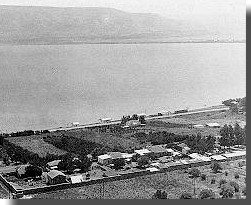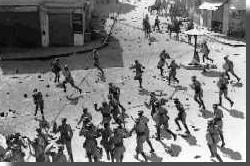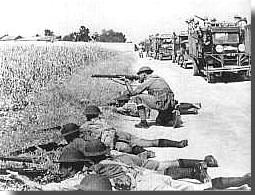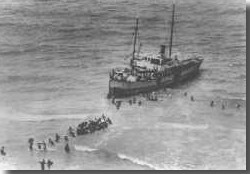MAPS & TERMS
I n t o T h e M a e l s t r o m
S e t t i n g
S e t t i n g
S e t t i n g
Background
photo caption
Moshav Kinerat on the Sea of Galilee, a Jewish rural settlement in British Palestine. In 1936 some 165 rural settlements (mostly kibbutzim) were spread across the land, their locations were strategically chosen for security and political reasons.
Photo courtesy of the
Israel Government
Press Office


Palestine in 1936 was a British colony brewing with tension and growing violence. That year, Palestinian Arabs initiated the latest in a series of violent actions was directed against the Jewish minority and the British colonial presence. Strikes and destruction aimed at economic paralysis were morphing into a campaign of guerilla warfare and terrorism. As the British worked to preserve their interests by sending in more military units and seeking political accommodation, continuing Arab violence was ensuring deaths on all three sides. Nationalist feelings on both the Jewish and Arab side were running high, and the political future of British rule was in doubt.
Palestine was a British colony formally since the Versaille Treaty created a Mandate from the land captured from Ottoman Turkey during WWI. From a mixture of wartime realist (seeking full U.S.A. involvement in the war and to seize a claim to land near the Suez Canal) and idealist (justice for Jews) motives, the British government with the 1917 Balfour Declaration committed themselves to the establishment of a Jewish homeland in Palestine under British rule. After the war, ensuring the stability of their Middle-Eastern empire with the large Arab population (and friendly monarchies with still under-developed oil) and safeguarding the strategic route through the Suez Canal became the more important goal. Jewish immigration was limited, favoritism toward the Arab leadership was practiced, and appeasement toward the more radical leadership undertaken. As one soldier of the time put it about the negative British attitude toward the Jews, "the indigenous Arab's manners, tolerance, good humor and haphazard way of life had more appeal to most than the sharper, more intense and dedicated lifestyle of the Jew...I could always sense a subtle barrier between us which was not only of language. Maybe it was brought about by the mild endemic antipathy towards Jews we had all grown up with over the centuries."1
Trying to balance law and order with the hope that Jews and Arabs could learn to live together, British authorities were unable to halt the violence. To the Jews, the government's failure to crack down on violence directed against them while limiting Jewish expansion meant it was not serious about deterring violence. To the Arabs, the British had promised self-autonomy but established a colony. And they were allowing immigration from a people they considered theologically inferior and politically alien, with an artificial ideology & threatening culture. Since the 1920s the local Arab leadership had opposed a Jewish presence out of mixed nationalist-religious motivations, aiming to achieve the goal of a sovereign all-Arab state with Jewish extermination or expulsion. They were determined to annihilate any Jewish belief in permanency, and to force the British to halt Jewish immigration and land sales. Violence against existing Jewish communities and against the creation of new Jewish settlements, to break Jewish resistance, became the means to this. The Mufti of Jerusalem, Haj Amin al-Husseini, the president of the Muslim Council (British-established body overseeing Muslim religious activities & organizations) was aiding the campaign of terrorism. This violent response to British policy with the expansion of Nazi Germany & Fascist Italy's conquering of Ethiopia (and British submission to their actions) was contributing to the regional Arab belief that British power could be weakening. And Axis penetration in the region grew.
photo caption
British police charge
stone-throwing Arab demonstrators. The targeting of informers and agents by the rebels weakened British intelligence & hampered counter-measures, as did retaliations against civilians by troops.
Photo courtesy of the Israel Government
Press Office
 In response to this violence and the grievances expressed by both sides, a Royal Commission was sent out that year, The Peel Commission. The commission researched and held hearings from late 1936 into 1937, searching for a political solution to the violence and to defend British interests. Publishing its recommendations in the summer of 1937, it called for the partition of Palestine. This included the creation of a tiny Jewish autonomous area, a larger autonomous Arab area, and a strategic corridor to be held by a British Mandate. Pleasing neither side, it was rejected by the Arab side. Violence, which was at a low level during the inquiry, exploded that September into open military attacks and terrorist actions.
In response to this violence and the grievances expressed by both sides, a Royal Commission was sent out that year, The Peel Commission. The commission researched and held hearings from late 1936 into 1937, searching for a political solution to the violence and to defend British interests. Publishing its recommendations in the summer of 1937, it called for the partition of Palestine. This included the creation of a tiny Jewish autonomous area, a larger autonomous Arab area, and a strategic corridor to be held by a British Mandate. Pleasing neither side, it was rejected by the Arab side. Violence, which was at a low level during the inquiry, exploded that September into open military attacks and terrorist actions.
The British authority was directly targeted along with the Jewish presence. Military troop strength had decreased during the period of the Peel inquiry, an army division having been brought in 1936 was withdrawn in 1937, cutting the size of the ground forces by half to just 2 brigades. Public security deteriorated as the police split, Arab & Jewish police defending their own. Troops were often forced to disperse for protective and defensive duties, hampered by indecisive civilian guidance. Arab guerilla bands were expanded in size and strength as they found popularity in the Arab villages and towns. Snipers harassed military patrols and groups ambushed and mined convoys. Terrorist actions grew in frequency, British civilians being murdered. Telegraph lines were downed, road and rail lines sabotaged, and the oil pipeline from Iraq to Haifa in Palestine attacked. Armed bands began raiding Jewish settlements, striking against roads and crop fields, attacking new settlements being created. Unarmed Jewish farmers and pedestrians were murdered, and civilians in cities for a period were being murdered every few days. Inter-Arab political feuds developed into an Arab civil war. Political opponents or moderates, or those who engaged in business with Jews were targeted for death. The British response became harsher, as police arrests and deportations of national political leaders (with the Mufti of Jerusalem fleeing to Nazi Germany) were not slowing the violence. Collective economic & financial punishment, the demolition of houses, military reprisals, and martial law were implemented (54 would be executed in 1938).3 In 1936, thousands of attacks and incidents resulted in 80 Jewish, 224 Arab, and 33 British deaths.4 1937-8 would demonstrate military control was tenuous.
photo caption
British troops practice counter-ambush drills in Palestine. Sweeps and mobile patrols struggled to bring the guerillas to open battle in the period 1936-37, the bare mountainous country with few good roads aiding the rebels.
Photo courtesy of Imperial War Museum, London
photo caption
Jewish refugees from Europe coming ashore from a clandestine Haganah smuggling ship. Those fleeing Europe faced bans immigrating to Western Europe & the Americas.
Photo courtesy of the Israel Government
Press Office
The Dilemma
 The Zionist Jewish leadership, the Jewish Agency, was determined to expand and protect the Jewish community ("Yishuv"). But it was facing difficult challenges. Land and buildings could be purchased from owners, and undeveloped land developed. Expanding anti-Semitism, and economic and political restrictions in Europe meant a massive influx of refugees as many began fleeing to Palestine from the dictatorships in Nazi Germany and Eastern Europe. But as Arab opposition to these actions grew, legal immigration was severely restricted by the British authorities and land purchasing was controlled too. Development of the Yishuv and clandestine immigration became goals. Up to the beginning of WWII, Jewish organizations brought in tens of thousands of Jews on illegal immigration ships. At this time the Jewish population numbered close to 400,000 compared to the nearly 1 million-size Arab population.5
The Zionist Jewish leadership, the Jewish Agency, was determined to expand and protect the Jewish community ("Yishuv"). But it was facing difficult challenges. Land and buildings could be purchased from owners, and undeveloped land developed. Expanding anti-Semitism, and economic and political restrictions in Europe meant a massive influx of refugees as many began fleeing to Palestine from the dictatorships in Nazi Germany and Eastern Europe. But as Arab opposition to these actions grew, legal immigration was severely restricted by the British authorities and land purchasing was controlled too. Development of the Yishuv and clandestine immigration became goals. Up to the beginning of WWII, Jewish organizations brought in tens of thousands of Jews on illegal immigration ships. At this time the Jewish population numbered close to 400,000 compared to the nearly 1 million-size Arab population.5
Present was a Jewish underground self-defense force called the Haganah. The Jewish leadership had realized they could not rely upon the British for protection, and was turning to self-defense. Technically the Haganah was an illegal force, the British having outlawed the establishment of any armed groups. Following the beginning of the 1936 riots and hard-pressed for manpower, the British reluctantly agreed to the creation of a small Jewish police force for local defense. This Jewish Supernumerary Police, or "Ghaffirs," was licensed light arms and uniforms. The force comprised local police for self-defense, and mobile units for rapid reinforcement. Soon mobile units were created, field companies called Fo'sh (Plugot Sadeh), and the Haganah made sure its members fielded the force. And so the police were becoming a legal cover for Haganah training, and Fo'sh operations became the secret striking arm and advanced training for operations such as patrolling and reinforcing settlements under assault. However, the Ghaffirs were limited in total numbers to just around 3,000.6 And the explosion of violence brought another conflict.

 The leadership of the Jewish Agency & Haganah were struggling trying to balance effective security with a policy of self-restraint ("Havlaga"). They believed that secrecy and sleekness in size were needed to avoid an open struggle with the numerically superior Arab world. And they wished to avoid damaging the British stance at official neutrality, thus risking curbs to all immigration, if they engaged in actions other than plain self-defense. But continuing Arab violence meant more Jewish deaths and destruction of property, and the rise of Nazi Germany meant reduced British flexibility. And continuation of Arab terrorism caused a few individuals to began retaliating for Jewish murders with terrorist acts against Arab civilians. A small but persistent faction began calling for open, armed rebellion, causing a small political splintering. So the leadership felt a stance to protect lives and prevent the situation from escalating was also important. The Yishuv was facing dangers to its political & physical survival.
The leadership of the Jewish Agency & Haganah were struggling trying to balance effective security with a policy of self-restraint ("Havlaga"). They believed that secrecy and sleekness in size were needed to avoid an open struggle with the numerically superior Arab world. And they wished to avoid damaging the British stance at official neutrality, thus risking curbs to all immigration, if they engaged in actions other than plain self-defense. But continuing Arab violence meant more Jewish deaths and destruction of property, and the rise of Nazi Germany meant reduced British flexibility. And continuation of Arab terrorism caused a few individuals to began retaliating for Jewish murders with terrorist acts against Arab civilians. A small but persistent faction began calling for open, armed rebellion, causing a small political splintering. So the leadership felt a stance to protect lives and prevent the situation from escalating was also important. The Yishuv was facing dangers to its political & physical survival.
When Captain Wingate reported for duty as an intelligence officer in September of 1936, there were no visible clues as to the future of this young and ambitious British officer. He belonged to a unit arriving as part of a plan to double the military garrison with a second infantry division. It was assumed by all that as an Arab-speaking officer with blood relations to a former governor-general of the Sudan, and with the typical English romantic pro-Arab feelings, he was going to be no different then any other British military officer assigned to the colony of the Empire.
1. Rex King-Clark, Free For A Blast
(London: Grenville, 1988), 152.
2. Howard Sachar, A History of Israel
(New York: Alfred Knopf, 1976), 211.
3. Sachar, 212.
4. Michael Cohen and Martin Kolinsky (eds), Britain and the Middle East In The 1930s (New York: St. Martins Press, 1992), 177.
5. Martin Gilbert, Israel
(New York: Harper & Row, 1995), 92.
6. Trevor Royle, Orde Wingate, Irregular Soldier (London: Weidenfeld & Nicolson, 1995), 115.
